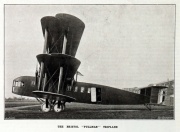Bristol Pullman: Difference between revisions
No edit summary |
No edit summary |
||
| Line 3: | Line 3: | ||
[[image:im1920v129-p7a.jpg|thumb|1920. Bristol Pullman Triplane. ]] | [[image:im1920v129-p7a.jpg|thumb|1920. Bristol Pullman Triplane. ]] | ||
[[image:im1920v129-p8a.jpg|thumb|1920. Interior of Pullman.]] | [[image:im1920v129-p8a.jpg|thumb|1920. Interior of Pullman.]] | ||
The Pullman was developed as a 14-passenger variant of the [[Bristol Braemar]] bomber. <ref>http://en.wikipedia.org/wiki/Bristol_Pullman</ref> | |||
The third prototype Braemar was completed as the prototype and sole Pullman and first flew early in May 1920. <ref>http://en.wikipedia.org/wiki/Bristol_Pullman</ref> | |||
1920 Shown at the International Aero Show at Olympia in July of that year, where its great size and interior fittings were much admired. <ref>http://en.wikipedia.org/wiki/Bristol_Pullman</ref> | |||
The Pullman was one of the earliest British aircraft to have a fully enclosed crew cabin, and this feature was disliked by service pilots, who often carried fireman's axes with them to enable them to escape in an emergency. <ref>http://en.wikipedia.org/wiki/Bristol_Pullman</ref> | |||
== See Also == | == See Also == | ||
Revision as of 10:26, 12 November 2014




The Pullman was developed as a 14-passenger variant of the Bristol Braemar bomber. [1]
The third prototype Braemar was completed as the prototype and sole Pullman and first flew early in May 1920. [2]
1920 Shown at the International Aero Show at Olympia in July of that year, where its great size and interior fittings were much admired. [3]
The Pullman was one of the earliest British aircraft to have a fully enclosed crew cabin, and this feature was disliked by service pilots, who often carried fireman's axes with them to enable them to escape in an emergency. [4]

